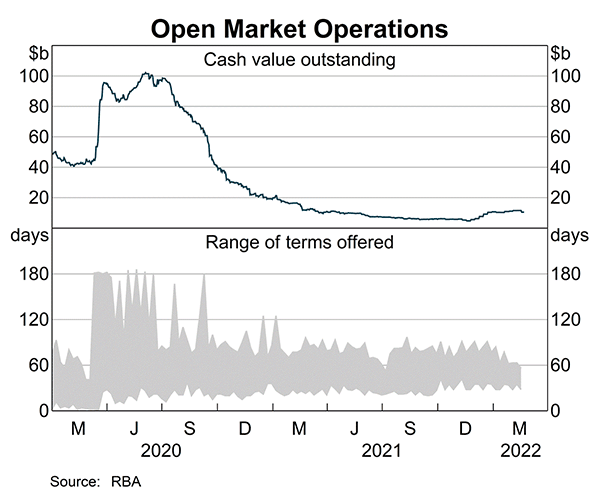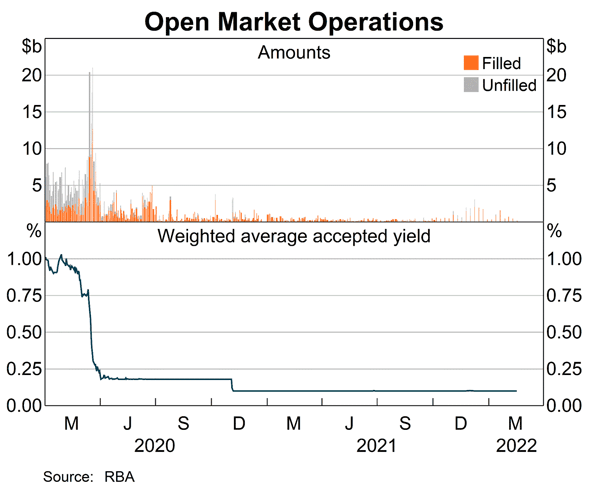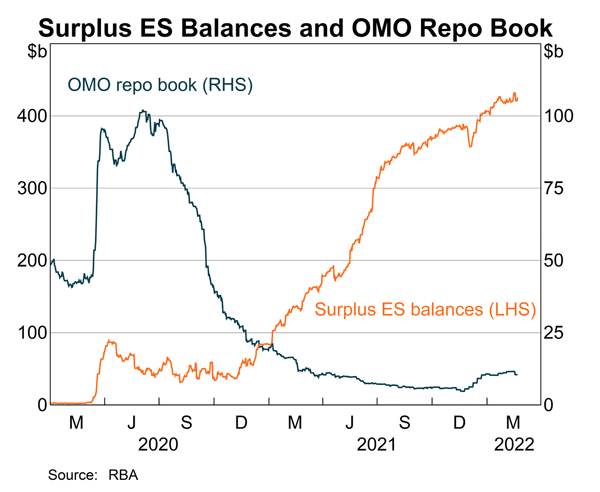Speech Changes to the Reserve Bank's Open Market Operations

Christopher Kent[*]
Assistant Governor (Financial Markets)
Remarks to the Australian Financial Markets Association
Sydney –
- Audio 37.2MB
- Q&A Transcript
- Download446KB
In 2020, the Reserve Bank adjusted its open market operations (OMO) in response to changing conditions in money markets, including those brought about by the Bank's monetary policy actions. It is now time to make further changes to OMO to ensure that the benefits of these operations are preserved as conditions evolve over time. The purpose of my talk today is to outline our plans for OMO and the reasoning behind them.
Background
At the onset of the pandemic, extreme uncertainty and the prospect of a significant decline in economic activity led to dislocation in global financial markets and a surge in the demand for liquidity. The Reserve Bank met that demand with an expansion in our OMO, increasing the size and lengthening the terms of the repurchase operations (repos) (Graph 1). The Bank also moved away from auctions in which the repo rate was determined by banks bidding for fixed quantities of liquidity. Instead, since April 2020, the Bank has been filling bids for liquidity (at the Bank's preferred terms) that are at or above a predefined hurdle rate (currently the cash rate target).[1] In this way, the OMO repo rates are fixed and the amounts dealt at OMO have been determined by the demand for this source of liquidity (Graph 2). This approach has been effective at addressing some pronounced shifts in demand.


There was an initial surge in demand for liquidity from OMO, which saw the Reserve Bank's repo book peak at around $100 billion in June 2020. The repo book then declined and is currently around $10 billion, well below pre-pandemic levels. This decline in the demand for liquidity from OMO makes sense. In particular, exchange settlement (ES) balances rose significantly as a result of the Term Funding Facility (TFF) and the bond purchase program (Graph 3).[2] This substantial rise in banking system liquidity means that banks have less need to obtain short-term funds and much greater capacity and willingness to lend them. Given the reduced demand for liquidity from the Reserve Bank's OMO, we shortened our preferred terms for OMO to between one and three months, with the average term to maturity of new repos declining to around seven weeks. We also reduced the frequency of OMO from daily to weekly.[3]

The Reserve Bank's balance sheet is likely to remain large for some time yet, because funding provided under the TFF will not mature until June 2024 at the latest and the Bank's holdings of government bonds will mature over many years. Accordingly, the supply of ES balances is likely to exceed demand for an extended period. The demand for liquidity from OMO is, therefore, likely to remain low.
Despite the reductions in the size, maturity and frequency of OMO, they remain an important part of the Reserve Bank's framework. OMO are a source of short-term liquidity for individual financial institutions, which for various reasons don't always have access to liquidity as readily as others (see below). OMO also provides a back-stop to the banking system as a whole in case there is a sudden broad-based increase in demand for liquidity. In other words, OMO can quickly help to relieve pressures in short-term money markets in the event of any unforeseen tightening in liquidity conditions. Reflecting these benefits, the Reserve Bank will continue to conduct OMO.
Changes
However, we are looking to adjust our operations in a number of ways. These changes are intended to ensure that OMO continues to provide the benefits I've just described, including in the face of changes that are likely to affect money markets in the future. I'll first describe the planned changes and then explain why we are pursuing these.
- The interest rate on OMO repos will change to a floating rate, which at this stage we plan to base on the average cash rate target prevailing over the term of the repo. Some other central banks already use floating rates in their liquidity operations, including the Bank of England and the European Central Bank.[4] Before we adopt floating rate repos, the Reserve Bank is looking to hear from market participants on the extent of adjustments that may be required to their systems to accommodate floating rates. Hence, we will allow for an appropriate transition period before making this change.
- In the meantime, the Bank will continue to apply a fixed hurdle rate for OMO. However, this hurdle rate will change from the current cash rate target to the rate on term-matched overnight indexed swaps (OIS) plus a modest spread. Initially this spread will be around 5 basis points, but subject to change depending on market conditions. The Bank will post the relevant hurdle rate for each preferred term with the announcements of our OMO dealing intentions.
- The maximum tenor of OMO repos will typically be four weeks, although longer terms may be offered if and when warranted by market conditions.
The shortening of OMO tenors will take effect immediately. Setting the hurdle rate as a spread to OIS will be effective from 30 March 2022; the cash rate target will remain the OMO hurdle rate until then. As already mentioned, the timing of the change to floating rate repos will be announced after we receive feedback on this aspect of the plan; we'll be in touch with relevant market participants in due course.
Reasons for change
I'll now turn to the reasons for these changes. First, however, I need to emphasise that these are operational adjustments and do not in any way provide guidance on the future path of monetary policy.
Now that the Bank has ceased purchases under the bond purchase program, the Bank's balance sheet will, in time, gradually start to decline.[5] In this environment, liquidity will remain ample for some time and most market participants are expected to continue to find it easy to source liquidity from private markets rather than the Reserve Bank. However, as mentioned earlier, OMO remains an important source of liquidity for some financial institutions. It is also a flexible way to quickly respond to liquidity pressures that might emerge from time to time across the banking system more broadly. It is important that the design of OMO remains appropriate to meet those objectives yet flexible enough to adapt to the liquidity environment as it evolves.
A key consideration in our OMO design is how to determine the hurdle rate. As I've mentioned, this is quite different to the pre-pandemic period, when the Reserve Bank targeted the quantity of liquidity to be provided through OMO, and repo rates were determined through a competitive auction process. Because the Reserve Bank no longer targets a set amount of system liquidity, there is no clear rationale for setting an OMO auction of a specific size. Instead, by setting the price of OMO liquidity, and filling bids at this level, the auction size automatically adjusts to any changes in demand, whether that demand is localised to a handful of banks and financial institutions, or is more widespread across the system.
Given the high level of system liquidity at present, most market participants find it relatively easy to source short-term liquidity without needing to use OMO. In this environment, it makes sense for the hurdle rate for OMO to be set above prevailing market rates in order to encourage market participants to use their existing liquidity or to tap into private markets instead. But the hurdle rate should not be so high that it discourages the use of OMO in the event of an unexpected broad-based increase in liquidity demand, when other sources of short-term liquidity may be very expensive or unavailable. Furthermore, we continue to see regular OMO participation from institutions that don't have large ES balances, and are less well connected to private markets, including because they might use collateral that is less widely accepted. OMO remains an important source of liquidity for these institutions in normal times, and the OMO hurdle rate should not be set so high that this liquidity becomes unduly expensive.
Looking ahead to the time when short-term money market rates eventually rise, it will no longer be appropriate to continue with a repo rate that is determined based on the cash rate target prevailing on the day of the OMO. If the OMO repo rate were to be below short-term money market rates of an equivalent term, demand for liquidity at the Bank's OMO would rise noticeably, potentially leading to destabilising moves in other markets. The move to base the OMO repo rate first on OIS plus a spread, and in time to a floating rate based on the cash rate target, will avoid such a situation.
Turning to our OMO tenors, in most circumstances OMO repos of four weeks or less will be sufficient to provide liquidity to eligible counterparties if they need it. Since the Bank will continue to fill OMO bids that meet the hurdle rate, and offer preferred terms with maturity dates that align with subsequent OMO auctions, participants will be able to roll their outstanding repo positions with the Reserve Bank. Of course, institutions can source liquidity from private markets for terms longer than four weeks as desired.
Conclusion
OMO remains an important part of the Reserve Bank's monetary policy toolkit. Over the past two years, it has complemented our other policy measures in providing accommodative financial conditions and supporting the economy. The operational changes that I have outlined today do not provide any guidance on the future path of monetary policy. Rather, they will ensure that OMO remains fit for purpose as liquidity conditions, the economic outlook and the Bank's monetary policies evolve. The shortening in the maximum typical terms for repos to four weeks will start with tomorrow's OMO. The use of term-matched OIS rates (plus a modest spread) for the repo rate will start from 30 March 2022. The timing of the switch to a floating repo rate will be determined after we receive feedback from market participants.
Endnotes
I thank Sean Dowling for his excellent assistance in preparing this material. [*]
Prior to the COVID-19 pandemic, the RBA used OMO to closely manage the supply of liquidity in order to ensure that the cash rate traded near to the target set by the RBA Board. The RBA offered a set amount of liquidity at OMO, and the price that counterparties paid (the repo rate) was determined through a competitive auction process. For more information, see Domestic Markets Department (2019), ‘The Framework for Monetary Policy Implementation in Australia’, RBA Bulletin, June. [1]
For a discussion of the mechanisms at work here, see Debelle G (2020), ‘Monetary Policy in 2020’, Australian Business Economists Webinar, 24 November. [2]
See Dowling S (2021), ‘Recent Changes to the Reserve Bank's Liquidity Operations’, RBA Bulletin, December. [3]
The interest rate on the Bank of England's Indexed Long Term Repo is the average Bank Rate over the term of the repo plus a spread. For details, see Bank of England (2022), ‘Bank of England Market Operations Guide: Our Tools’, 31 January. Available at <https://www.bankofengland.co.uk/markets/bank-of-england-market-operations-guide/our-tools>. The interest rate on the European Central Bank's Long Term Refinancing Operations are indexed to the Main Refinancing Operation repo rate. [4]
The decision regarding possible reinvestment of maturing bonds will be made at the May Board meeting. [5]